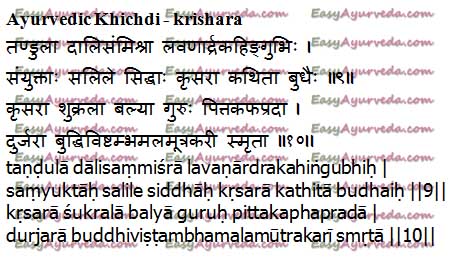Ayurvedic Khichdi: How To Make? Benefits, Side Effects
This article is by Dr M S Krishnamurthy MD(Ayu), PhD.
Whenever I introduce myself as an Ayurvedic writer to a western student, he or she asks, “Have you written about Khichdi?” I say no. And there starts the suspicion in his mind about my credibility. I intend to get rid of that suspicion today!
Khichdi is the first recipe that a foreigner learns in an Ayurveda class.
Kichdi is most common kind of food prepared to serve for morning breakfast, lunch and even for dinner too. In India in several temples and charitable institutions, it is served as Prasadam too.
Even though contents and consistency may vary from one region to another basic ingredients will remain same. In this write up classical view about this preparation is discussed-
Table of Contents
Classical reference

Classical reference of Ayurvedic Khichdi: Bhavaprakasha – Kritanna varga/10
What is Kichdi?
Rice and pulses (Daal) are taken together and cooked well with water. In practice rice and dal are taken in 4:1 ratio; the proportion may be altered as per ones liking and necessity.
While cooking or in the end stage of cooking rock salt, ginger and asafoetida (heeng) are added. As the amount is not fixed as per ones necessity it may be added.
Some add coconut, groundnut, cashew nut etc also. One can add similar additives if found suitable for the added benefits.
Usually this is semi solid in consistency and some may prefer it in liquid consistency too.
Note: Some add little ghee, turmeric powder, cumin seeds etc too. Or else ghee is added while serving,by few of the people.
Qualities, actions, applications
Qualities:
Guru (heavy) for digestion,
Durjara (gets digested slowly).
Action:
Shukrala (promotes seminal quality and quantity),
Balya (tonic/nutritive),
Pitta kapha vardhaka – increases Pitta and Kapha Dosha,
Buddhi Vardhaka(memory enhancer),
Vishthambhakaraka (constipating),
Malavardhaka (increase the bulk of stool),
Mutravardhaka (increase the quantity of output of urine).
Application:
Due to the above said qualities it is apt to use among the patients who are having the repeated craving for the food, uncontrolled appetite etc.
As Kichdi is very nutritive, it fulfills dietary need and hence advised for growing children. But it should be avoided if the individual is having poor digestion capacity, reduced appetite, constipation, indigestion etc.
Khichdi can be recommended to the people who are lean and emaciated, having good appetite with the desire to gain weight.
Those who are having the distension of abdomen, burping, gaseous distension, acid peptic disorders etc can have Panak, lemon juice or buttermilk after having the Khichdi.
Click to consult Dr MS Krishnamurthy MD (Ayu), PhD
Sushruta
कफपित्तकरी बल्या कृशराऽनिलनाशना॥
kaphapittakarī balyā kṛśarā’nilanāśanā|| Sushruta Sutrasthana 46th chapter
Krsara- thick gruel / kichdi – prepared by boiling tila, (sesame), tandula (rice) and masa (Black gram), increases Kapha and Pitta, mitigates Vata and bestows strength.
It is useful to improve digestion strength and nourishment while keeping Vata under check.









